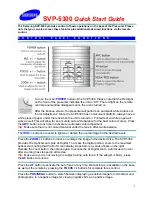
9
3 Service Navigation
3.1.
Introduction
This service manual contains technical information, which will allow service personnel's to understand and service this model.
Please place orders using the parts list and not the drawing reference numbers.
If the circuit is changed or modified, the information will be followed by service manual to be controlled with original service manual.
3.2.
Air-leak test (inspection)
• This product was tested using Panasonic’s internal test standard, which is in accordance with :
Waterproof/Dustproof : IEC60529 IP58, certified to a depth of 3.0 m (60 minutes),
Shockproof : MIL-STD-810F Method 516.5-Shock, compliant to a height of 1.5 m.
• Due to the characteristics of the products, perform the air-leak test (inspection) using Air -leak tester (Part No.:RFKZ0528)
before/after servicing including assembly and/or assembly process.
NOTE:
The purpose of the air-leak test before servicing is that whether the malfunction occurred due to air-leak or not.
• When servicing, refer to the "7.Troubleshooting" section in details.
3.3.
Replacing the waterproof packing (waterproof seal)
• The integrity of the waterproof packing may decrease about 1 year, with use and age.
(We recommend end users to replace the waterproof packing (waterproof seal) at least once each year described
in the operating instructions.)
• As for replacement procedure, refer to the 7.1.2.Periodical maintenance (Packing replacement) flow in details.
3.4.
Lens Unit
Since the lens unit for this model is assembled with high accuracy manufacturing technologies, it is not allowed to disassemble/
assemble the lens unit, in terms of performance retention.
When servicing, it has to be handled the "Lens with CCD unit" as the smallest part size.
Refer to each section, disassembly/assembly procedure, exploded views and replacement parts list replacement parts list for lens
part, in details.
3.5.
General Description About Lead Free Solder (PbF)
The lead free solder has been used in the mounting process of all electrical components on the printed circuit boards used for this
equipment in considering the globally environmental conservation.
The normal solder is the alloy of tin (Sn) and lead (Pb). On the other hand, the lead free solder is the alloy mainly consists of tin
(Sn), silver (Ag) and Copper (Cu), and the melting point of the lead free solder is higher approx.30
°
C (86
°
F) more than that of the
normal solder.
Definition of PCB Lead Free Solder being used
Service caution for repair work using Lead Free Solder (PbF)
• The lead free solder has to be used when repairing the equipment for which the lead free solder is used.
• (Definition: The letter of
is printed on the PCB using the lead free solder.)
• To put lead free solder, it should be well molten and mixed with the original lead free solder.
• Remove the remaining lead free solder on the PCB cleanly for soldering of the new IC.
• Since the melting point of the lead free solder is higher than that of the normal lead solder, it takes the longer time to melt the
The letter of
is printed either foil side or components side on the PCB using the lead free solder.
(See right figure)
Summary of Contents for DMC-FT1EB
Page 15: ...15 4 Specifications ...
Page 16: ...16 ...
Page 18: ...18 ...
Page 19: ...19 ...
Page 20: ...20 ...
Page 21: ...21 5 Location of Controls and Components ...
Page 22: ...22 ...
Page 31: ...31 7 2 Air leak Test ...
Page 32: ...32 7 3 Air leak Test Inspection ...
Page 33: ...33 ...
Page 37: ...37 9 Disassembly and Assembly Instructions 9 1 Disassembly Flow Chart 9 2 PCB Location ...
Page 39: ...39 9 3 2 Removal of Top Ornament Fig D2 Fig D3 ...
Page 40: ...40 9 3 3 Removal of Rear Case Unit Fig D4 Fig D5 ...
Page 42: ...42 Fig D7 9 3 5 Removal of Main P C B Battery Case Fig D8 ...
Page 43: ...43 Fig D9 9 3 6 Removal of Main P C B Fig D10 ...
Page 44: ...44 Fig D11 9 3 7 Removal of Flash P C B Fig D12 ...
Page 45: ...45 9 3 8 Removal of Top P C B Fig D13 Fig D14 ...
Page 46: ...46 9 3 9 Removal of Rear Operation P C B Fig D15 Fig D16 ...
Page 47: ...47 Fig D17 9 3 10 Removal of LCD Unit Fig D18 ...










































